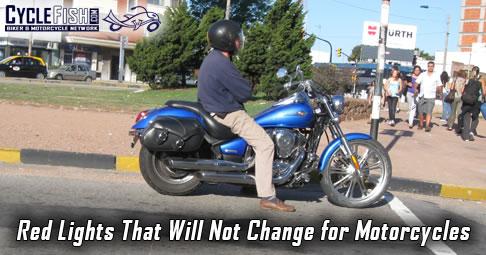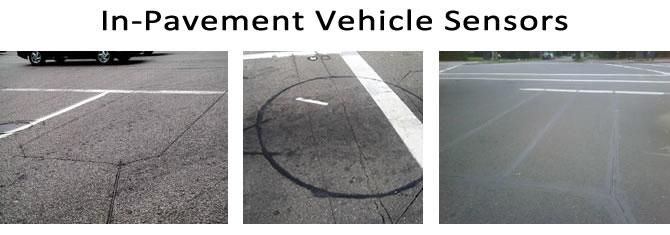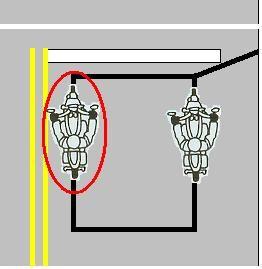
More states adding "Dead Red" laws to allow Motorcycles to legally proceed through a red light that won't change (scroll dow for a list of states).
Have you ever sat at a red light, that will not turn green, with no other traffic around? Maybe the light is broke, but more than likely the traffic sensors do not even know you are there. Red lights, or traffic signals, change using two different methods. One way is (typically in rural or low traffic areas) on a timer. However most traffic lights these days are 'smarter' than that (especially in cities and high traffic areas) and they use sensors to determine when the light should change depending on the traffic pattern or the presence of a vehicle.
Looking for Motorcycle Events?
There are two common types of traffic control sensor systems; in-pavement and over-the-road
An over-the-road system typically uses an array of detection devices (motion sensing video cameras, lasers, infrared, etc) to determine the presence of a vehicle. These types of sensors are normally very effective and can detect the presence of autos, motorcycles and even bicycles.
An in-pavement system is the one that can cause problems for smaller vehicles including motorcycles. In-payment systems uses either wire loops embedded in the pavement that create a magnetic field that detects the presence of a vehicle by its mass of metal, or they use a weight sensor to detect the presence of a heavy vehicle on the road. The problem with both of these types of in-pavement systems is that a lot of times motorcycles do not have the mass or weight required to trigger the system and the light will never change.
One thing you can do to improve your odds of the systems recognizing the presence of your motorcycle is to properly place your motorcycle on the sensor when stopping for a red light. The in-payment sensors can normally be identified by looking for where they cut the road to place the sensors.


Notice the rider circled in the figure above. He has the tires on top of the loop wires. This is the place where you need to be when you are riding alone. The other bike in the figure is also on the loop wires and helps send the signal to the controller to change the light. Not all intersections have loops, and sometimes you can't see the saw marks where the loop wires are, but if you stop in the circled area, you increase your odds at turning the red light to green.
Luckily there are a number of states now addressing this issue by creating "Dead Red" Laws that allow a Motorcycle Rider to proceed through a red light that does not change because the vehicle presence system did not recognize the presence of the motorcycle at the intersection. Below is a list of "Dead Red" laws we have found so far. Most do have restrictions on how and when you can proceed throug a red light that doesn't change. We stress that you follow these guidelines in addition to observing the utmost safety precautions when proceeding through a red light.
States with "Dead Red" Laws
Arkansas – (2005) State law allows a motorcyclist to proceed with caution, after coming to a full and complete stop, through a red light that fails to detect the bike. (Arkansas Code section 27-52-206)
California – (2009) The driver of any vehicle approaching an intersection which has official traffic control signals that are inoperative shall stop at the intersection, and may proceed with caution when it is safe to do so. (California Vehicle Code 28100(D)(1). However there is a chance you may have to argue this in court since the light is only malfunctioning under specific circumstance.
Colorado – (2019) Whenever a driver approaches an intersection and faces a traffic control signal which is inoperative or which remains on steady red or steady yellow during several time cycles, the rules controlling entrance to a through street or highway from a stop street or highway, as provided under section 42-4-703 , shall apply until a police officer assumes control of traffic or until normal operation is resumed. In the event that any traffic control signal at a place other than an intersection should cease to operate or should malfunction as set forth in this section, drivers may proceed through the inoperative or malfunctioning signal only with caution, as if the signal were one of flashing yellow. (Colorado Revised Statute 42-4-612)
Florida – The driver of a vehicle approaching an intersection in which the traffic lights are inoperative shall stop in the manner indicated in s. 316.123(2) for approaching a stop sign intersection. In the event that only some of the traffic lights within an intersection are inoperative, the driver of a vehicle approaching an inoperative light shall stop in the above-prescribed manner. (Florida Statute s. 316.1235)
Idaho – (2006) If a signal fails to operate after one cycle of the traffic light that a motorcyclist may proceed, using due caution and care, after coming to a full and complete stop at the intersection. (Statute 49-802)
Illinois – (2012) Permits a driver of a motorcycles or bicycle facing a red light that fails to change within a reasonable period of time of not less than 120 seconds to proceed after yielding the right-of-way to any oncoming traffic. However, this law doesn’t apply to municipalities of over 2,000,000 people – such as Chicago. (625 ILCS 5/11-306)
Indiana - (2016) - A motorcycle, moped, and bicycle riders who fail to trigger a traffic signal at an intersection may proceed through a red light, so long as the rider first stops for two minutes and then proceeds cautiously.
Kansas – (2012) Motorcycles may proceed at a non-responsive red light when safe and after a reasonable amount of time. (KS Statutes, Chapter 8, Article 15, Section 8, C4)
Kentucky – (2015) Motorcyclists must come to a complete stop, wait for at least two minutes or two light cycles and make sure no other vehicles are crossing the intersection before proceeding. (HB 370)
Minnesota – (2002) A person operating a bicycle or motorcycle who proceeds through a red light has an affirmative defense if the driver first came to a complete stop, the traffic light stayed red for an unreasonable amount of time and appeared not to detect the vehicle and no motor vehicles or people were approaching the street. (Statute 169.06)
Missouri – (2009) State law tells both motorcyclists and bicyclists that proceed through red lights that they have an affirmative defense if they brought their vehicle to a complete stop, the light was red for an unreasonable time period, and there were no motor vehicle or person approaching. (Statute 304.285)
Nevada – (2013) Those using motorcycles, bicycles, mopeds, and tri-mobiles are allowed to proceed through an intersection with a red light after waiting for two traffic light cycles, and they yield to other vehicle traffic or pedestrians. (Statute 484B.307)
North Carolina – (2007) Motorcyclists are permitted to move cautiously through a steady red light after coming to a complete stop and waiting a minimum of three minutes and if no other vehicle or pedestrians are approaching the intersection. (NCGS 20-158)
Ohio – (2017) Motorists can proceed through red lights if the light isn’t working properly and only if the intersection is clear of oncoming traffic. Note: If cited for going through a red light the motorist has the burden to prove it was malfunctioning.
Oklahoma – (2010) Motorcycles can proceed cautiously through a steady red light intersection after a making a complete stop and if no other motor vehicle or person is approaching the roadway. (Statute 47-11-202)
Oregon - (2016) Allowed to "proceed with caution" after one full cycle of signal light
Pennsylvania - (2016) If a traffic control signal using automated technology fails to detect the presence of a vehicle the driver may proceed thru the red light using caution and the rules related to a stop sign (i.e. allow other vehicles and pedestrians with the right of way to pass thru the intersection before proceeding).
South Carolina – (2008) After making a complete stop and waiting for a minimum of 120 seconds, the driver of a motorcycle, moped, or bicycle may treat a steady red light that doesn’t change as a stop sign and proceed with caution. (S.C. Code 56-5-970)
Tennessee – (2003) Notwithstanding any law to the contrary, the driver of a motorcycle approaching an intersection that is controlled by a traffic-control signal utilizing a vehicle detection device that is inoperative due to the size of the motorcycle shall come to a full and complete stop at the intersection and, after exercising due care as provided by law, may proceed with due caution when it is safe to do so. (Tennessee Traffic Control Signals 55-8-110)
Utah - (2015) Allowed to proceed after being at a full stop at a red light for over 90 seconds
Virginia – (2011) Drivers of motorcycles, mopeds, and bicycles may move with caution through non-responsive red lights as long as they yield the right-of-way to others approaching the intersection, and have come to a complete stop for two complete light cycles or 120 seconds, whichever is shorter.(Statute 46-2-833)
Wisconsin – (2006) A motorcycle, moped or bicycle is permitted to proceed through a steady red light after making a complete stop and waiting at least 45 seconds and then yields the right–of-way to any vehicular traffic or pedestrians using the intersection. (Statute 346.37)
Washington – (2015) During the last legislative session, a new section was added to Chapter 46.61 RCW in Washington State that allows the operator of a street legal motorcycle to make a left turn, after stopping at an intersection that is controlled by a triggered traffic control signal, if the device fails to operate after one cycle of the traffic signal. (Amendment to Chapter 46.61 RCW)
There are a number of other states currently looking into passing similar "Dead Red" laws. Lawmakers and Motorcycle Safety groups are realizing this is not only an inconvenience, but also a safety issue. If your state does not currently have a Dead Red law you should contact your state representative and push them on this. Also, as always, support your state's Motorcycle Rights Organization(s) and make sure they are working with lawmakers on this issue.
Note: The state laws listed above were verified as accurate at the time this article was updated to the best of our ability. As always check you local laws and stay up to date on any changes.
Looking for Motorcycle Events?
September 16, 2011- -
-
1 likes this
- -
-
Report